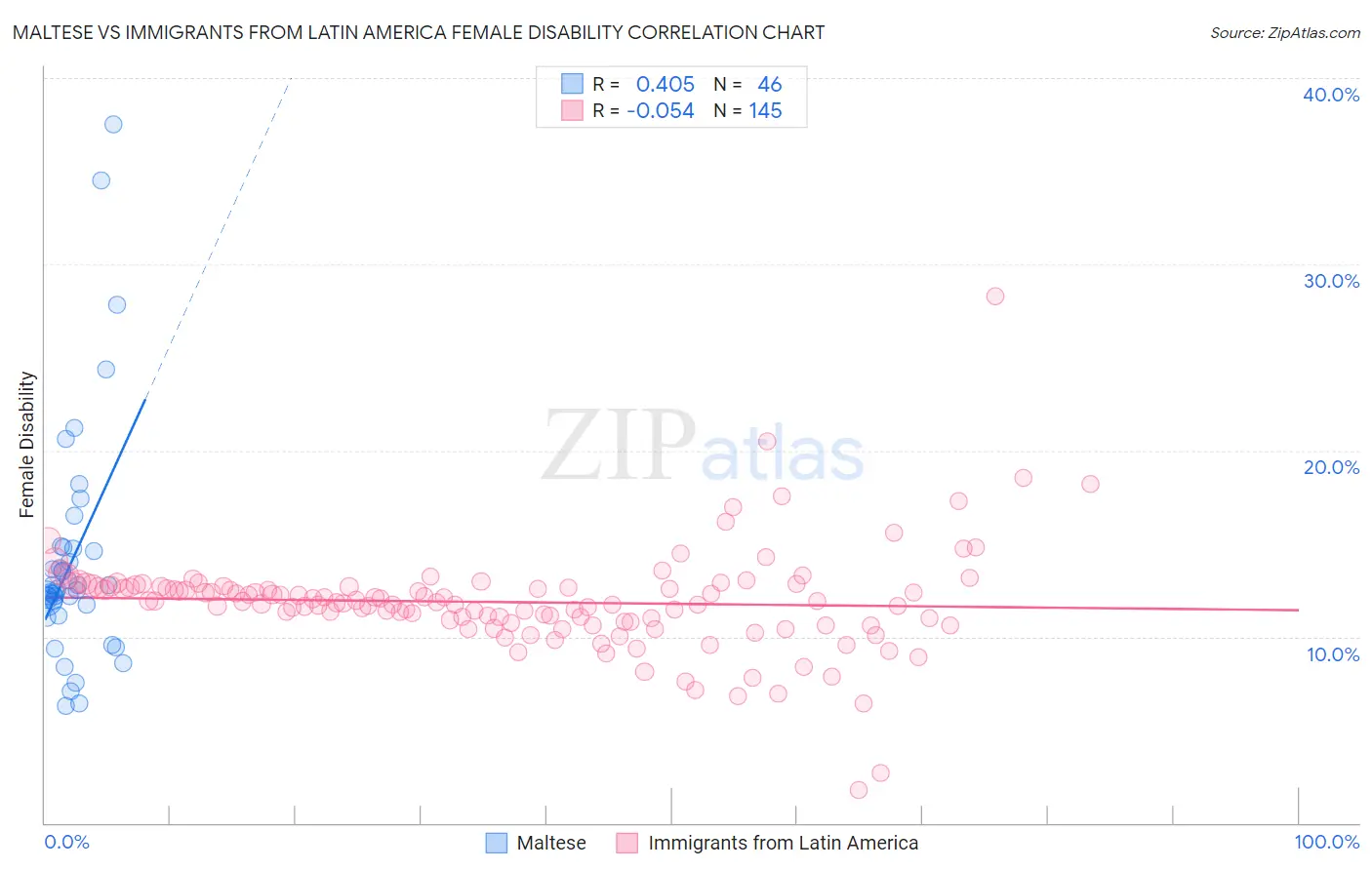Maltese vs Immigrants from Latin America Female Disability
COMPARE
Maltese
Immigrants from Latin America
Female Disability
Female Disability Comparison
Maltese
Immigrants from Latin America
12.2%
FEMALE DISABILITY
57.0/ 100
METRIC RATING
170th/ 347
METRIC RANK
12.2%
FEMALE DISABILITY
59.0/ 100
METRIC RATING
167th/ 347
METRIC RANK
Maltese vs Immigrants from Latin America Female Disability Correlation Chart
The statistical analysis conducted on geographies consisting of 126,465,818 people shows a moderate positive correlation between the proportion of Maltese and percentage of females with a disability in the United States with a correlation coefficient (R) of 0.405 and weighted average of 12.2%. Similarly, the statistical analysis conducted on geographies consisting of 558,350,253 people shows a slight negative correlation between the proportion of Immigrants from Latin America and percentage of females with a disability in the United States with a correlation coefficient (R) of -0.054 and weighted average of 12.2%, a difference of 0.080%.

Female Disability Correlation Summary
| Measurement | Maltese | Immigrants from Latin America |
| Minimum | 6.3% | 1.8% |
| Maximum | 37.5% | 28.3% |
| Range | 31.2% | 26.5% |
| Mean | 14.1% | 11.9% |
| Median | 12.5% | 11.9% |
| Interquartile 25% (IQ1) | 11.7% | 10.8% |
| Interquartile 75% (IQ3) | 14.7% | 12.7% |
| Interquartile Range (IQR) | 3.0% | 1.9% |
| Standard Deviation (Sample) | 6.3% | 2.8% |
| Standard Deviation (Population) | 6.3% | 2.8% |
Demographics Similar to Maltese and Immigrants from Latin America by Female Disability
In terms of female disability, the demographic groups most similar to Maltese are Immigrants from Southern Europe (12.2%, a difference of 0.030%), Lebanese (12.2%, a difference of 0.040%), Immigrants from Haiti (12.2%, a difference of 0.070%), Lithuanian (12.2%, a difference of 0.10%), and Immigrants from Oceania (12.1%, a difference of 0.19%). Similarly, the demographic groups most similar to Immigrants from Latin America are Immigrants from Haiti (12.2%, a difference of 0.010%), Lithuanian (12.2%, a difference of 0.020%), Lebanese (12.2%, a difference of 0.040%), Immigrants from Oceania (12.1%, a difference of 0.11%), and Immigrants from Southern Europe (12.2%, a difference of 0.11%).
| Demographics | Rating | Rank | Female Disability |
| Immigrants | Middle Africa | 72.4 /100 | #158 | Good 12.1% |
| Immigrants | Central America | 67.7 /100 | #159 | Good 12.1% |
| Immigrants | Guatemala | 66.0 /100 | #160 | Good 12.1% |
| Guyanese | 64.7 /100 | #161 | Good 12.1% |
| Immigrants | Ukraine | 64.3 /100 | #162 | Good 12.1% |
| Guatemalans | 63.8 /100 | #163 | Good 12.1% |
| Czechs | 63.6 /100 | #164 | Good 12.1% |
| Immigrants | Oceania | 61.8 /100 | #165 | Good 12.1% |
| Lithuanians | 59.5 /100 | #166 | Average 12.2% |
| Immigrants | Latin America | 59.0 /100 | #167 | Average 12.2% |
| Immigrants | Haiti | 58.8 /100 | #168 | Average 12.2% |
| Lebanese | 58.1 /100 | #169 | Average 12.2% |
| Maltese | 57.0 /100 | #170 | Average 12.2% |
| Immigrants | Southern Europe | 56.3 /100 | #171 | Average 12.2% |
| Haitians | 51.9 /100 | #172 | Average 12.2% |
| Immigrants | Mexico | 50.8 /100 | #173 | Average 12.2% |
| Immigrants | England | 50.0 /100 | #174 | Average 12.2% |
| Immigrants | St. Vincent and the Grenadines | 49.7 /100 | #175 | Average 12.2% |
| Immigrants | Guyana | 43.1 /100 | #176 | Average 12.2% |
| Immigrants | Ghana | 42.5 /100 | #177 | Average 12.2% |
| Immigrants | Western Europe | 40.9 /100 | #178 | Average 12.2% |